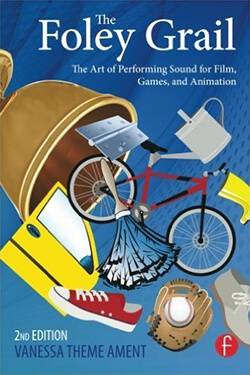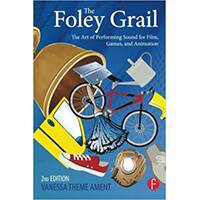‘The Foley Grail’ – book review
 The Foley Grail: The Art of Performing Sound for Film, Games and Animation
The Foley Grail: The Art of Performing Sound for Film, Games and Animation
Second Edition
Author: Vanessa Theme Ament
Publisher: Focal Press
There’s a much-bandied about quote (the earliest instance of which I can track down being a mention in Kit Laybourne’s The Animation Book in 1979; any earlier sources welcome) that puts forward the idea of sound being 70% responsible for the impact of any animated film.
While that may be contestable, after all the years I’ve spent absorbing animation in all its forms it can’t be denied that bad sound, or its absence altogether, will kill an otherwise promising piece of work stone dead. As this year’s crop of new animation talent is rolling in, it’s clear that despite the rise of high quality visuals, the dreaded laissez-faire approach to sound and music still pervades many a student or indie production (and even a few mainstream commercial projects, to be brutally honest).
For anybody who wishes to take their approach to this area of production seriously, The Foley Grail is a solid jumping-off point. Though relatively brief at roughly 250 pages, it’s a dense yet accessible study and demystification of one of filmmaking’s more gentle arts, penned by Vanessa Theme Ament (whose extensive professional background in both live-action and animated features includes Disney’s Beauty and the Beast and A Goofy Movie).
Being in its second edition, the book opens with a number of acknowledgments toward certain knowledge gaps present in its first iteration, indicating a desire to broaden its areas of focus beyond mainstream Hollywood production. In this respect this updated text has a greater relevance to the world of animaton production, its wide variety of audiences and its ever-increasing appeal as an auteur/indie medium lending itself often to less conventional, more outside-the-box approaches to sound construction. With the first chapter detailing the history of foley (and the pioneering efforts of its namesake Jack Foley and such contributors to the craft as John Post, Aldo Ciorba and Robert Rutledge), those that immediately follow paint an endearingly informal picture of its development, cultural backdrop and varying approaches to theory before diving into the practical side of things. To those who’ve not worked within the hierarchies of a studio system, the book provides an interesting look at the ways in which sound crews are managed to most effectively streamline a production pipeline, as well as offering reference illustrations for cue sheets, crew interactions and movie scene breakdowns from the sound editor’s point of view.
Hefty portions of the book detail the practice of Foley creation itself, leading to some of its most enjoyable passages in which artists anecdotally recount their experiences and experimentations in the studio (the chapter Magic Wind in particular). What is enforced most of all is just how all-encompassing sound really is, how many considerations need to be in place and just how much of a constant balancing act is required to sell any moment of film as ‘real’ to an audience.
The area of the book most immediately useful to those in animation would be Part 3: Foley Beyond the Film Frame, which delves into a number of special considerations for video games and animated film projects. Approaches to sound in animation generally vary (the fidelity to real-life environments in a Pixar feature is obviously worlds apart from the inventive sound repurposing and substitution of a Looney Tunes short) and the parallels and disparities between approaches to sound compared to live-action are discussed, along with additional strands of historical backstory and development by the likes of Disney’s Jimmy Macdonald, whose resourcefulness and non-traditional Foley background enabled some of the craft’s less typical approaches. From an animator’s perspective it’s obviously the section that perhaps could benefit the most by way of expansion, especially considering the author’s own experiences on animated feature films. Given how applicable the greater percentage of the book is to budding sound designers or directors/producers keen to broaden their awareness of the practice, this is really just a small personal niggle.
Ultimately as one of several books out there that deal with this subject, The Foley Grail is a strong all-rounder and, lacking any impulse to impress or alienate with academic formality (specific terminologies are also helpfully addressed in the glossary) a very pleasant read.
Items mentioned in this article:


